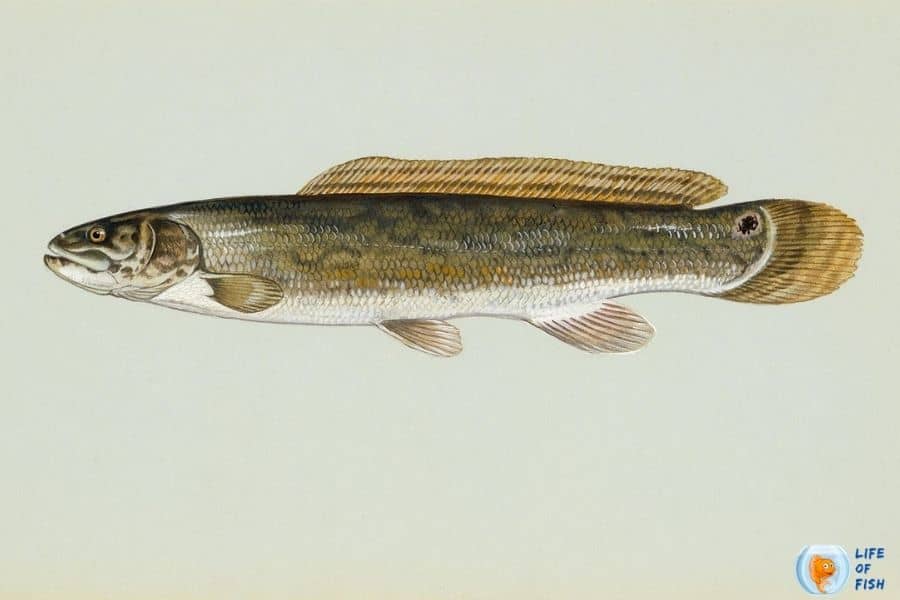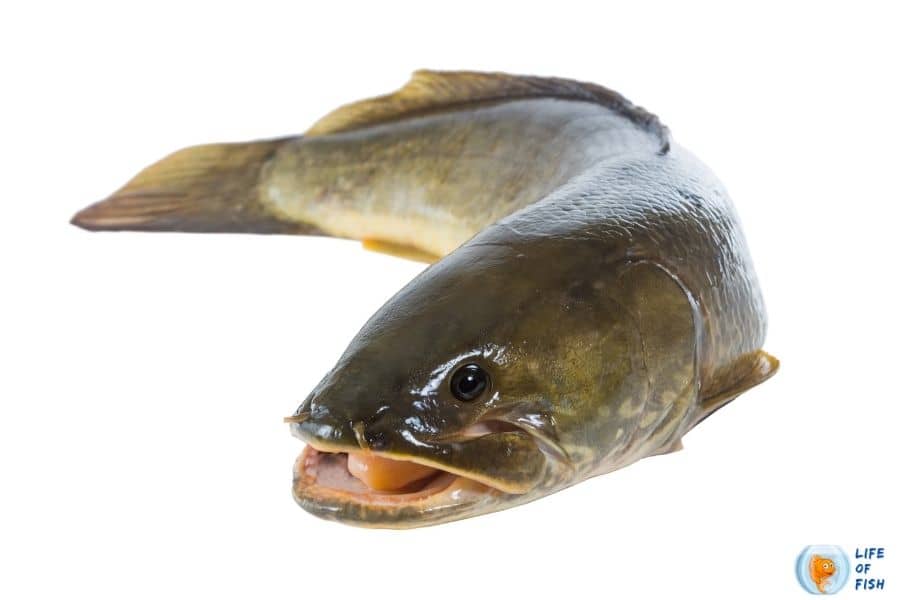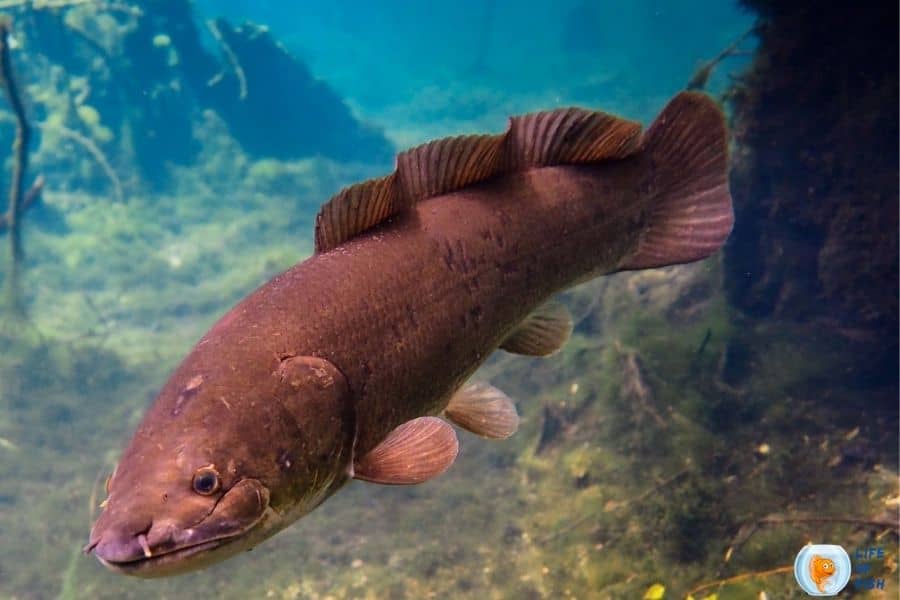Can bowfin bite you? Let’s find out. Bowfin is not as cute as its name. They are among North America’s “living fossils” with incredibly aggressive nature and exciting habits.
They say that bowfins are one of the meanest predators in the world. This statement may be somewhat accurate since they have been known to bite their fair share of previous anglers.

More about bowfin.
Jump To
- 1 More about bowfin.
- 2 Can Bowfin bite you?
- 3 Does Bowfin have teeth?
- 4 Does a bowfin bite hurt?
- 5 Is Bowfin aggressive?
- 6 Is Bowfin poisonous?
- 7 Do bowfins attack humans?
- 8 How big do Bowfin get?
- 9 Where do bowfins live?
- 10 What do bowfins eat?
- 11 How long do bowfins live?
- 12 Can you eat a bowfin?
- 13 How do you cook Bowfin?
- 14 Are Bowfin and snakehead the same?
- 15 Is a bowfin a burbot?
- 16 Is Bowfin endangered?
- 17 Conclusion
Amia calva, commonly called Bowfin, is a freshwater fish species belonging to the Amiidae family under order Amiiformes.
They are also known as Dogfish and mudfish in some regions. They are indigenous to North America, and their presence is recorded from Costa Rica onwards.
A bowfin has a distinctive appearance; it has an elongated body with a long dorsal fin, which is half of the fish’s total length when erected.
They swim through their abdominal position without moving their tail or pectoral fins.
It is a carnivore, and it eats just about anything they find on their way, including insects, smaller fishes, and even young birds.
They can eat prey larger than the extent of their mouths due to protruding jaws and a set of conical teeth, which allow them to chew and swallow large prey items.
A bowfin’s mouth is not that big, and it can be stretched to impressive sizes when it hunts for its prey.
It has a pair of tubular nostrils close to each eye, but experts believe they can’t smell anything.
Can Bowfin bite you?
Yes. Bowfins are fearless predators that try to attack and eat whatever moves around them.
So, if you are near them, with any part under the water (let’s say, your finger), they can and will bite you to eat that part.
However, they may not be able to break apart your finger bones to swallow the bit inside, but they will surely leave a scar on your fingertip.
Does Bowfin have teeth?
Bowfins have teeth that are canine-like, small, sharp, and numerous.
Because of these canine-like teeth, these fish can give a carnivorous scowl, which might be why they are nicknamed Dogfish.
Bowfin teeth
Bowfins are bony fish that have a skull. The teeth of these fish are fixed on the premaxillae and the maxillae bone, situated on the head.
These teeth are canine-like, sharp, small, and numerous. The teeth, along with their unique body shape, give these fish a fearsome look.
Bowfins use their teeth to catch and hold their prey. These fish have a broad diet, and they feed on fishes, frogs, plants, insects, mussels, and even other bowfins.
Does a bowfin bite hurt?
Like we said before, bowfins have sharp, canine-like teeth that can tear apart naked human skin. So, a bowfin bite should hurt you unless you have hairy skin like a dog or a bear.
If a bowfin bites you, the first thing to do is wash the wound with clean running water and peroxide.
Then, rinse and dry the wound and apply some antibacterial cream or antibiotic ointment on the affected area.
It will hurt for a while, and it might swell up, depending on the severity of the wound.
Is Bowfin aggressive?
Bowfin is one of the most aggressive fish that you can find.
They are fierce predators, and they will not hesitate to attack anything that moves near them, except other bowfins during mating season.
These fish are known to attack anglers by jumping out of the water and slapping them, resulting in a painful offensive wound.

Is Bowfin poisonous?
Apart from being dangerous because of their aggressive nature, these fish are not poisonous to humans.
Bowfin bites may cause bacterial infections but, they do not contain poison. Bowfins are also safe to eat.
Do bowfins attack humans?
Yes. There are numerous news, documentation, and even video captions of bowfins attacking humans.
According to US FWS, bowfins even don’t hesitate to leave the water to attack a man on the land.
They are so mean predators that they try to predate on any living thing they can find. (Like scary Piranhas in the movies).
How big do Bowfin get?
Bowfins can grow up to 41 inches in the wild. However, these fish typically grow around 20 to 28 inches in the wild.
The maximum recorded weight of these fish is 9.75kg.
Where do bowfins live?
Bowfins inhabit freshwaters throughout the eastern United States, southern Ontario, and southwestern Québec.
They live in freshwater lakes, rivers, streams, ditches, and even ponds with a good water supply.
These fish are often found in St. Lawrence River, Lake Champlain, and around the Great Lakes in southern Ontario into Minnesota.
What do bowfins eat?
Bowfins are predatory fish that has a broad diet. These fish feed on fishes, frogs, plants, insects, mussels, and even other bowfins.
In fact, these fish attack anything that moves near them, hoping to predate on it.
Bowfin is bony fish, and they have sharp canine-like teeth that help them catch their prey very easily.
How long do bowfins live?
The average lifespan of bowfins is 20 years. However, few live beyond 30 years if the conditions are favorable.
But, these fish tend to have a shorter life span in the wild. They do not usually live more than 12 years in the wild.
Can you eat a bowfin?
Bowfins are edible fish, but they are not tasty. In fact, no one really eats these fish because there are much more delicious fish out there available to catch in the same freshwater habitats.
Mose anglers consider bowfins “trash fish” because they prey on most “food fish,” including crayfish. Therefore, most anglers tend to kill these fish when they find them.

How do you cook Bowfin?
The bony structure of these fish makes it difficult to prepare for cooking without removing the bones. So, the best way to clean these fish is by removing its head and scales.
You can remove their heads by cutting across behind the gills. You can scale the fish very easily by scraping the scales from tail to head with a dull knife or a spoon.
Bowfins are mostly fried because these bony fish are very difficult to grill. They have a soft and poor texture and taste bland, even after cleaning the fish and removing all the bones.
Are Bowfin and snakehead the same?
Bowfins and Snakeheads are freshwater fish that shares similar characteristics. Therefore, people often confuse these two.
The main difference between them is that Snakeheads are considered an invasive species in the USA, while Bowfins are not.
Snakeheads belong to the family Channidae and are native to Africa and Asia. But bowfins belong to the family Amiidae and are native to the USA.
Snakehead closely resembles Bowfin, but you can see distinct differences between these fishes if you observe.
Bowfins have a short anal fin, while the anal fin of snakeheads is long. The pelvic fin of the Bowfin is located at the mid-body, while the snakehead’s pelvic fins are located near the head.
Snakeheads do not have bony plates between lower jawbones like bowfins. Snakeheads have enlarged scales on the head, but bowfins do not.
If you catch a snakehead from a lake, river, or any other freshwater habitat in the USA, do not release it into the wild.
Instead, call the Wildlife department of your area and inform them about the fish you caught.
Is a bowfin a burbot?
Many people confuse bowfins as burbots or otherwise. But, the truth is Bowfin is not Burbot.
Bowfins and Burbots are different species of fish native to the United States. Both fish inhabit freshwaters, and both are carnivores.
But, Bowfin is a bony fish that belongs to the family Amiidae, and Burbot is a gadiform (cod-like) fish that belongs to the family Lotidae.
Both fish species have almost similar characteristics, but there are distinct differences in the body shape, which are pointed out below.
- Bowfins have rounded, broad heads, but Burbots have flattened heads with chin barbels.
- Bowfins’ lower fins are often greenish, and burbots’ fins are brownish.
- Pelvic fins of bowfins are set back under the dorsal fin. The pelvic fins of Burbots are located beneath the pectoral fins.
- Bowfins’ anal fins are short, but Burbots’ anal fins are long.
- Burbots have two distinct dorsal fins, while bowfins have only one long dorsal fin.
- Bowfins often have a dark spot near the tail, but Burbots lack this feature.
Is Bowfin endangered?
Bowfins are not rare and abundant in their natural habitats in North America. However, anglers are known to kill these fish whenever they find them because most of their diet consists of food fish.
But, still, these fish are not listed as endangered because they are widely distributed around various habitats across the northern part of the USA.
Conclusion
Bowfins are one of the meanest predators in the world. They can bite you and have teeth that are canine-like, small, sharp, and numerous.
The Bowfin inhabits fresh waters throughout the eastern United States, southern Ontario, and southwestern Québec; they live in freshwater lakes, rivers, streams, ditches, and even ponds with a good supply of water. It’s an edible fish but not tasty at all!
Read Next : Types Of Gar Fish | 7 Fearless Fish With Compariosion |
